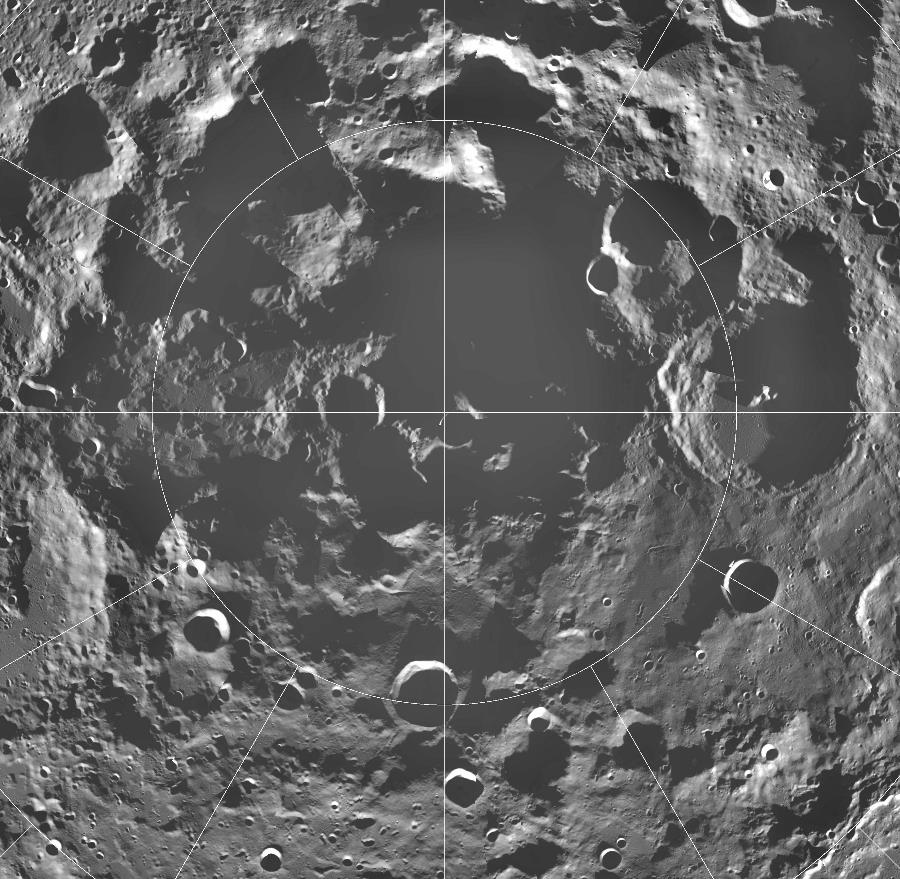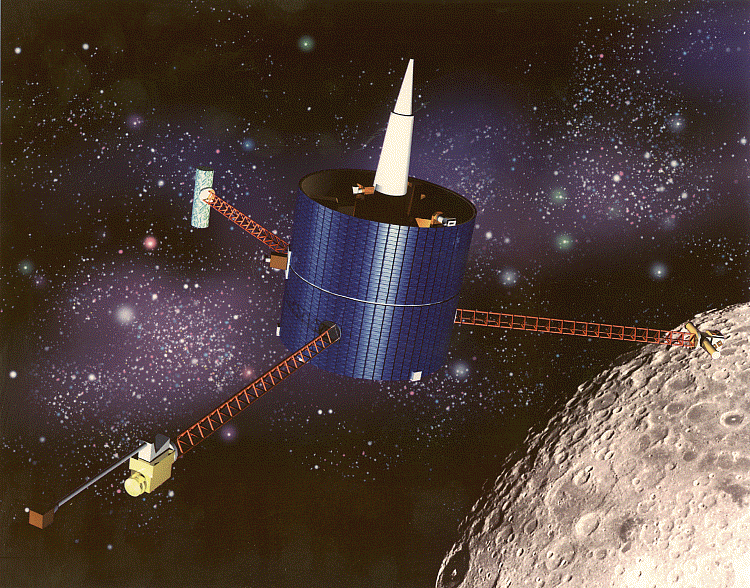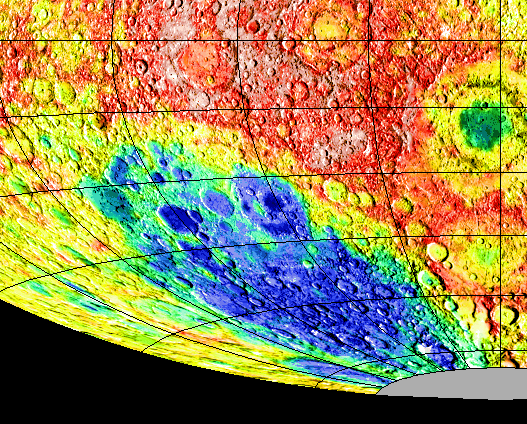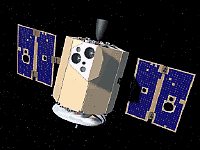|
Lunar Water |
|||
|
Subject: Discovery of Ice on the Moon ..
U.S. Department of Defense
Presenter: Dr. Dwight Duston, Assistant Deputy for Technology, Ballistic Missile Defense Organization; Tuesday, December 3, 1996 - 1:45 p.m.
Dr. Dwight Duston, Assistant Deputy for Technology,
Ballistic Missile Defense Organization;
Colonel Bridges: Good afternoon, ladies and gentlemen. My name is Colonel Dick Bridges. I'm the new Director for Defense Information, for those of you that don't know me. I have a couple of admin announcements. First of all, the Memorandum for Correspondents that you've been provided concerning this briefing as well as the fact sheet, I understand that we don't have enough copies for everyone. We're making additional copies. They will be available during the briefing or certainly afterwards. I would also like to mention to you that between this briefing and our regularly scheduled Department of Defense news briefing there will be a ten minute break so that those of you that want to file can do so. I realize ten minutes isn't all that much time. I would also like to mention that pictures of the South Pole of the moon as well as some other shots of the Clementine moon craft are available on DefenseLINK. We put them up there this morning. Now it gives me great pleasure to be able to introduce to you Dr. Dwight Duston. Dr. Duston is the Assistant Deputy for Technology of the Ballistic Missile Defense Organization. As such, he is responsible for all research and development for missile defense. He will introduce experts associated with the project who will brief you on their roles in this remarkable discovery of water ice on our moon. SOURCE: Discovery of Ice on the Moon - U.S. Department of Defense Dr. Spudis: Thank you, Stew. I'd like to briefly discuss sort of two aspects to this amazing discovery. First of all, from a scientific viewpoint, what does this mean? Secondly, from a utilization viewpoint, what good is it? From the scientific viewpoint, you've got to ask yourself where could ice come from on the moon? We know from the Apollo samples that the moon is extremely dry. In fact all the Apollo samples studied to date show no evidence whatsoever for any water or any kind of hydrous phase being present in the lunar interior. So I think the idea that water may have out-gassed from the moon, from the lunar interior over time, probably isn't the case. I think the answer is when you look at the pictures of the moon you see huge amounts of craters. And we know after studying the moon for 30 years, that most of these craters were formed by comets and asteroids. Now comets are made up predominantly of water ice. That is the dominant component of a comet. There are other volatile components. There's methane, there's ammonia, there are even organic molecules that are present in comets. All these volatile elements, elements that have very low boiling points, are concentrated in comets because comets formed in the outermost part of the solar system, and Jupiter has perterred them over geologic time into the inner solar system where they hit the moon. Now the significance of the dark area becomes apparent because as the comet hits the moon, that water vapor hangs around the moon as a cloud. If any water vapor gets into a cold trap, which by the way is only about 40 degrees centigrade above absolute zero, so they're extremely cold. If a water molecule gets into the cold trap, it cannot get out again. It doesn't have enough thermal energy to hop out and there's no way to knock it out. So over time, over three billion years, you could accumulate a significant amount of water ice in the dark area. What does this mean scientifically? It means that for the first time we know on the moon that we have a preserved record of the cometary impact flux over geologic time. So we can go there, study this deposit, and actually understand possibly how has the cometary flux changed with time? Has the source areas of comets over time changed? Do they migrate inward with time? All these are questions we don't know, but the answers are on the moon, and they're on the moon in this dark area. The second aspect I'd like to discuss is the utilization part of this. As you're probably aware, water is one of the most valuable strategic objects, strategic materials that we can find in the solar system. Not only does it produce water for human life support -- both water to drink and to disassociate into oxygen and hydrogen, oxygen to breathe -- but water is also a very good rocket propellant. When you electrolyze water into hydrogen and oxygen and you liquefy them, you produce basically the same fuel that the space shuttle uses in its main engines -- liquid oxygen and liquid hydrogen. So for the first time we now know that there are deposits of water at the South Pole of the moon that are there, apparently accessible and ready to use for this purpose -- both to support human life, and to produce rocket fuel. Finally, I'll point out one thing on this diagram. If you look at the very center of this mosaic of the South Pole, you'll see there's a slightly lit area right at the center of the cross- hair. It's just at about the South Pole. It turns out that this is an area that is -- this area right here, right near the South Pole -- is lit, and it's in close proximity to all this darkness. Now it turns out we've studied this particular area over the course of a lunar month, and it turns out that this area is also illuminated 85 percent of the time, and it's surrounded by areas that are in near permanent darkness. The significance of that is, if you were to go to this spot on the moon, you could use thermal or you could use solar panels for electrical power for the duration of the mission because the sun would effectively never set. It would always be above the horizon. It might dip below a mountain for a few hours of the 708-hour lunar day. So you may be looking, in this photograph, at possibly the most valuable piece of real estate in the solar system. It's certainly a place where we can go, utilize the resources, and live in an area that's actually benign environmentally on the moon. The use of indigenous materials in space has been studied for a long time. We've known from the Apollo results that there's hydrogen in the lunar regula, and it's produced there by the solar wind, and planted on the grains. But it's present in extremely tiny amounts -- less than about 50 parts per million in most of the soils. In this area the water that's there is probably present in abundances between one and ten percent, and that's a significant amount of water. It's also water that's easily recoverable. If we were to recover this, and electrolycize it, disassociate it into hydrogen and oxygen, we would actually be able to build a filling station on the moon. So one of the reasons space travel is so expensive is that we have to lug everything we need up with us from earth's orbit, this huge gravity well. By having materials that we can use on the moon to refuel that's already in earth orbit, we save an enormous amount of weight and an enormous amount of cost. So the significance of this to the future exploration of the solar system is very profound. SOURCE: Discovery of Ice on the Moon - U.S. Department of Defense Questions and Answers: Q: Can somebody address why this announcement is coming from the Pentagon? Why this is a Pentagon project? And if it suggests in any way any military use or contemplation of the use of the moon? A: The reason we did the experiment in the first place, as Colonel Rustan said, was to highlight and test these advanced technologies that we and other military organizations had been developing over the years. Typically we test, in the missile defense business, we test our sensors against targets. This was a low budget enterprise, so we decided to use a target that Mother Nature had put up for us, that was the moon. We could get totally adequate testing of all our sensors and our laser radar using the moon as opposed to paying millions of dollars of taxpayers' money for targets we would put up directly. Q: Where is Clementine now? A: The spacecraft, as you know, from the name Clementine, is only supposed to be here for a short period of time and be lost and gone forever, so it was intended for a very short period of time after this lunar mission, did a rendezvous with the earth, and shortly after that was shifted by the moon's gravity and continued a flight which will bring it back near the earth about nine years from now. So it's an 11 year total flight around the sun. So basically it's moving like a little planet around the sun, and it will bring it back close to us in about nine years... It's two years since it left us so it will be another nine years before it's back. But it's not useful right now. The mission is finished. Q: But unlike it's namesake, it's not lost and gone forever. It will be back? A: It will be back, but it's not a useful spacecraft any more. Q: What do you think this would look like if you could go right down and see it? Would you see a fairly large pond here, other ponds all over the place, some ice in crevices and rocks? A: You would probably see... First of all you wouldn't see anything because you'd be in the dark. But if you had a flashlight and you illuminated the surface, you would see a surface that looked not unlike any place else on the moon, but if you were to dig down into that and pull it up, you would find that there would be ice crystals contained in the interstices between the dust grains. So it's not a sheet or a pond. It's not an ice rink on the moon. It's basically ice mixed into the dirt. Q: What's the presumptive volume of it then, and how did you discern that? A: As I mentioned, what we can tell from looking at the radar return is roughly the area that is covered by this. Assuming it reflects ice like ice on Mercury -- making that assumption. That's been well looked at. Then in order to see this back scatter effect, this roadside reflector effect; it's estimated that we have to see some number of wavelengths of our radar into the ice. In reviewing the paper, several of the reviewers posited we probably need to see somewhere between 50 and 100 wavelengths. So our wavelength is about six inches. So at the thickest case, it's roughly 50 feet. Q: That translates to what in volume? A: We were very conservative in the press release, but if you take basically 100 square kilometers by roughly 50 feet, you get a volume of something like a quarter of a cubic mile, I think it's on that order. It's a considerable amount, but it's not a huge glacier or anything like that. Q: Can you compare that with something you know? A: It's a lake. A small lake. Q: But it's a dirt lake. A: Right, mixed in. (Laughter) A dirty lake. Q: Do you hope there's much more? Do you hope this means there's a bunch more? A: We didn't actually look into the deepest part of the craters because of the limitation of the geometry, what you can see from earth. So in the paper we say this is probably a lower limit to the amount that's there. Q: You talked about the bright spot in the middle of the shadow. What's its size? Is it navigable? Would it be suitable as a landing site? A: Tens of square kilometers. SOURCE: Discovery of Ice on the Moon - U.S. Department of Defense |
|||
|
Ice on the Moon ..
Ice on the Moon On 5 March 1998 it was announced that data returned by the Lunar Prospector spacecraft indicated that water ice might be present at both the north and south lunar poles, in agreement with Clementine results for the south pole reported in November 1996. Later work has called this interpretation into question, so the issue is still unresolved. The ice originally appeared to be mixed in with the lunar regolith (surface rocks, soil, and dust) at low concentrations conservatively estimated at 0.3 to 1 percent. Subsequent data from Lunar Prospector taken over a longer period has indicated the possible presence of discrete, confined, near-pure water ice deposits buried beneath as much as 18 inches (40 centimeters) of dry regolith, with the water signature being stronger at the Moon's north pole than at the south (1). The ice was thought to be spread over 10,000 to 50,000 square km (3,600 to 18,000 square miles) of area near the north pole and 5,000 to 20,000 square km (1,800 to 7,200 square miles) around the south pole, but the latest results show the water may be more concentrated in localized areas (roughly 1850 square km, or 650 square miles, at each pole) rather than being spread out over these large regions. How was the ice detected?
How can ice survive on the Moon? The Moon has no atmosphere, any substance on the lunar surface is exposed directly to vacuum. For water ice, this means it will rapidly sublime directly into water vapor and escape into space, as the Moon's low gravity cannot hold gas for any appreciable time. Over the course of a lunar day (~29 Earth days), all regions of the Moon are exposed to sunlight, and the temperature on the Moon in direct sunlight reaches about 395 K (395 Kelvin, which is equal to about 250 degrees above zero F). So any ice exposed to sunlight for even a short time would be lost. The only possible way for ice to exist on the Moon would be in a permanently shadowed area.
The Clementine imaging experiment showed that such permanently shadowed areas do exist in the bottom of deep craters near the Moon's south pole. In fact, it appears that approximately 6000 to 15,000 square kilometers (2300 to 5800 square miles) of area around the south pole is permanently shadowed. The permanently shadowed area near the north pole appears on Clementine images to be considerably less, but the Lunar Prospector results show a much larger water-bearing area at the north pole. Much of the area around the south pole is within the South Pole-Aitken Basin (shown at left in blue on a lunar topography image), a giant impact crater 2500 km (1550 miles) in diameter and 12 km deep at its lowest point. Many smaller craters exist on the floor of this basin. Since they are down in this basin, the floors of many of these craters are never exposed to sunlight. Within these craters the temperatures would never rise above about 100 K (280 degrees below zero F) (2). Any water ice at the bottom of the crater could probably exist for billions of years at these temperatures. Where did the ice come from? The Moon's surface is continuously bombarded by meteorites
and micrometeorites. Many, if not most, of these impactors contain water
ice, and the lunar craters show that many of these were very large objects.
Any ice which survived impact would be scattered over the lunar surface.
Most would be quickly vaporized by sunlight and lost to space, but some
would end up inside the permanently shadowed craters, either by directly
entering the crater or migrating over the surface as randomly moving individual
molecules which would reach the craters and freeze there. Once inside the
crater, the ice would be relatively stable, so over time the ice would
collect in these "cold traps", and be buried to some extent by meteoritic
gardening. Such a possibility was suggested as early as 1961 (3). However,
loss of ice due to photodissociation, solar wind sputtering, and micrometeoroid
gardening is not well quantified (4).
In a Science magazine article (5) on 29 November 1996, it was announced that interpretation of data from a Clementine spacecraft experiment suggested the possibility of ice on the surface of the Moon. The ice was believed to be in the bottom of a permanently shadowed crater near the Moon's south pole (at the center of the Clementine mosaic shown at the top of the page). It was also thought likely that other frozen volatiles, such as methane, were in the deposit. The deposit was estimated to be approximately 60,000 to 120,000 cubic meters in volume. This would be comparable to a small lake in size, four football fields in surface area and 16 feet deep. This estimate was very uncertain, however, due to the nature of the data. One of the problems in studying a permanently shadowed area is that no pictures can be obtained. The Clementine spacecraft searched for the ice using an investigation known as the Bistatic Radar Experiment. Basically, this experiment consisted of having the Clementine spacecraft transmit an S-band radio signal through its high gain antenna towards a lunar target. The signals reflected off the Moon and were received by a 70 meter Deep Space Network (DSN) antenna on the Earth. Frozen volatiles such as water ice are much more reflective to S-band radio waves than lunar rocks. Radio waves also have different characteristics when reflected off ice than off silicate rock. An analysis of the signals returned from orbit 234 showed reflection characteristics suggestive of water ice for the permanently shadowed areas near the south pole. Reflections from regions which are not permanently shadowed do not show these characteristics. It is possible that other scattering mechanisms could be responsible for this result, but the interpretation of the radio returns and the fact that they are associated only with the permanently shadowed regions seem to indicate that water ice is the most likely possibility. However, Arecibo radio telescope studies using the same radio frequency as Clementine showed similar reflection patterns from areas which are not permanently shadowed. These reflections have been interpreted as being due to rough surfaces, and it was suggested that the Clementine results may have been due to roughness, rather than water ice, as well. Bistatic Radar Experiment Parameters
Why is ice on the Moon important? The ice could represent relatively pristine cometary or asteroid material which has existed on the Moon for millions or billions of years. A robotic sample return mission could bring ice back to Earth for study, perhaps followed by a human mission for more detailed sampling. The simple fact that the ice is there will help scientists constrain models of impacts on the lunar surface and the effects of meteorite gardening, photodissociation, and solar wind sputtering on the Moon. Beyond the scientifically intriguing aspects, deposits of ice on the Moon would have many practical aspects for future manned lunar exploration. There is no other source of water on the Moon, and shipping water to the Moon for use by humans would be extremely expensive ($2,000 to $20,000 per kg). The lunar water could also serve as a source of oxygen, another vital material not readily found on the Moon, and hydrogen, which could be used as rocket fuel. Paul Spudis, one of the scientists who took part in the Clementine study, referred to the lunar ice deposit as possibly "the most valuable piece of real estate in the solar system". It appears that in addition to the permanently shadowed areas there are some higher areas such as crater rims which are permanently exposed to sunlight and could serve as a source of power for future missions. References:
|
|||
| FAIR USE NOTICE: This page contains copyrighted material the use of which has not been specifically authorized by the copyright owner. Pegasus Research Consortium distributes this material without profit to those who have expressed a prior interest in receiving the included information for research and educational purposes. We believe this constitutes a fair use of any such copyrighted material as provided for in 17 U.S.C § 107. If you wish to use copyrighted material from this site for purposes of your own that go beyond fair use, you must obtain permission from the copyright owner. | |||
|
|




